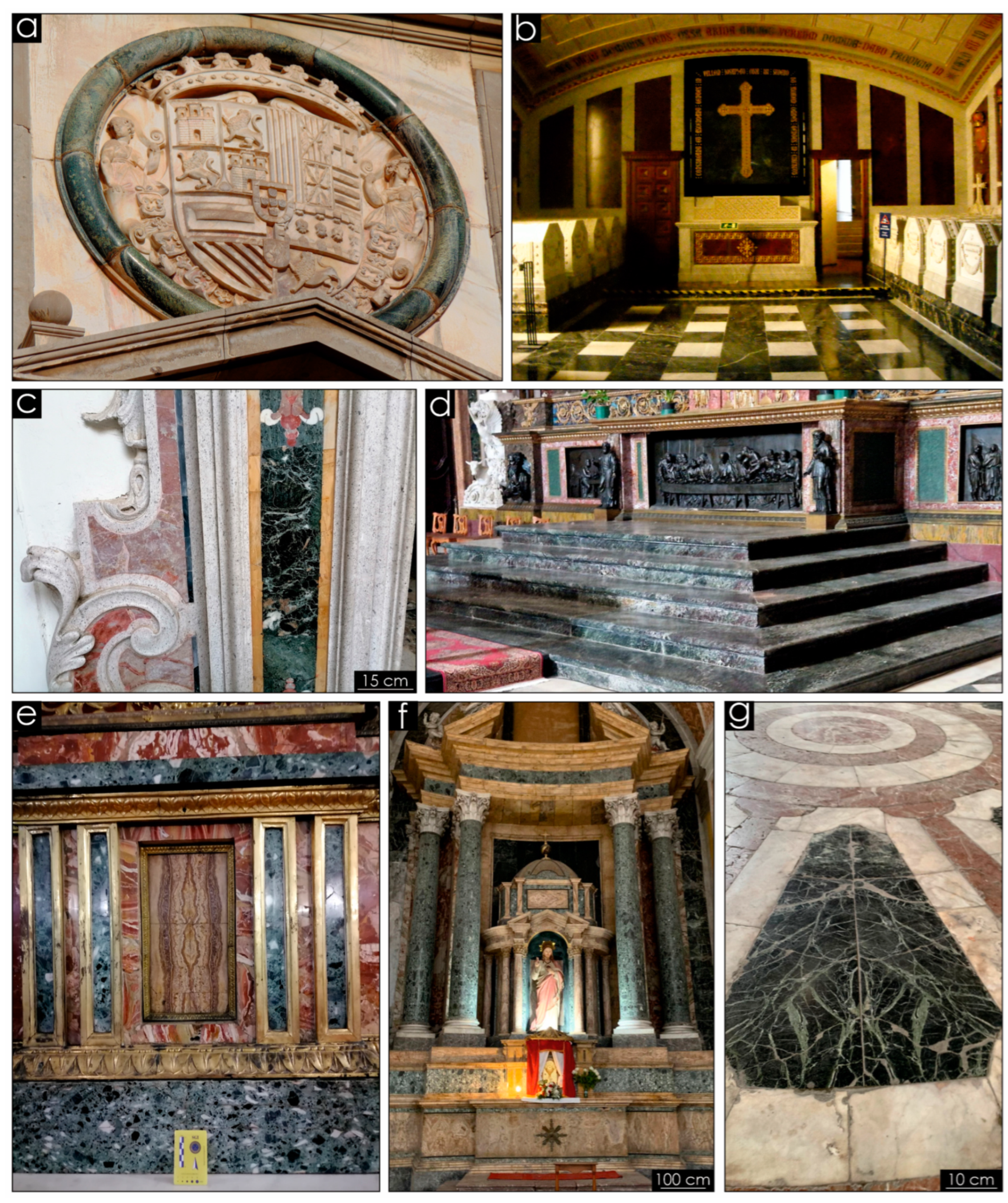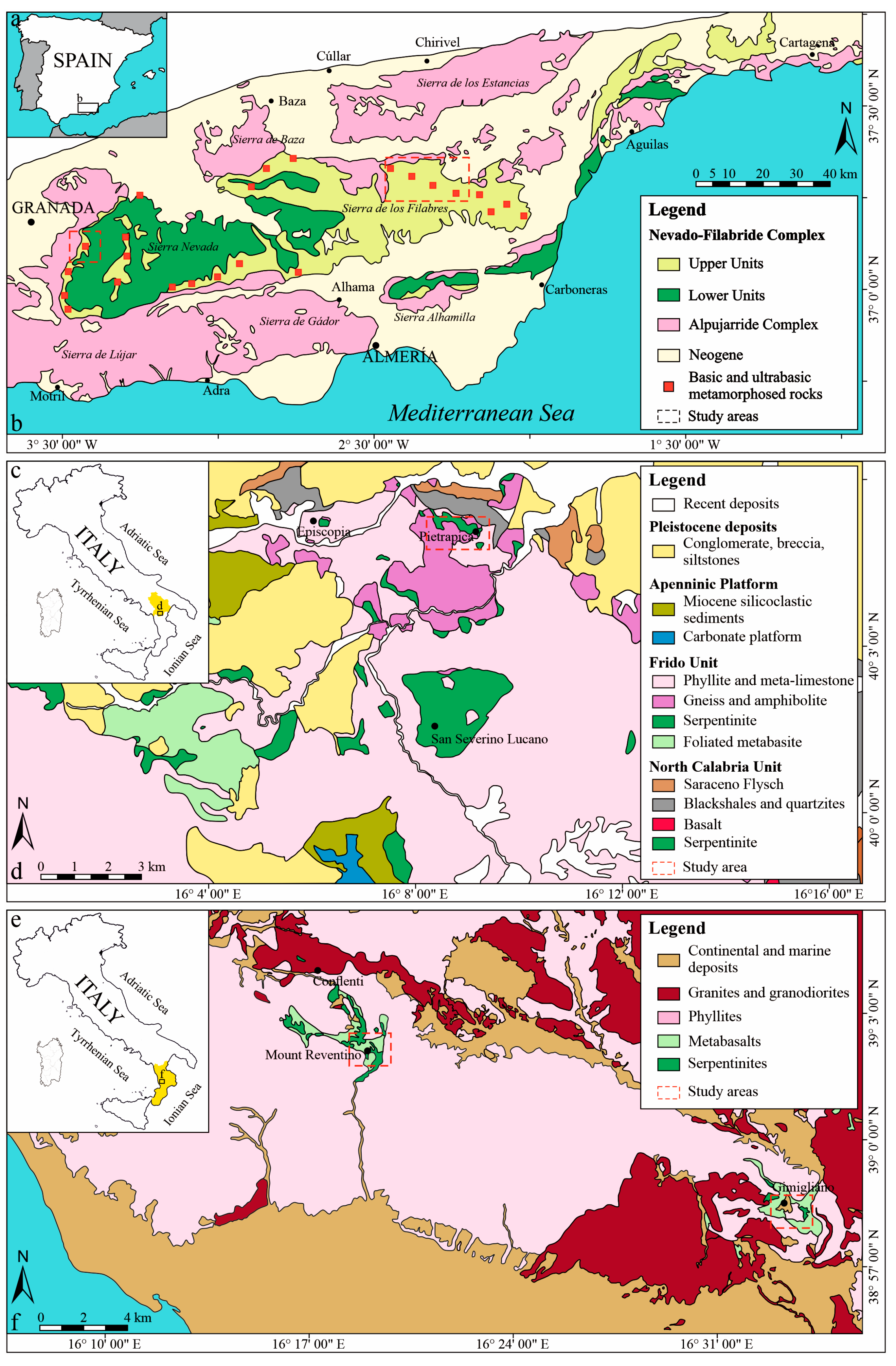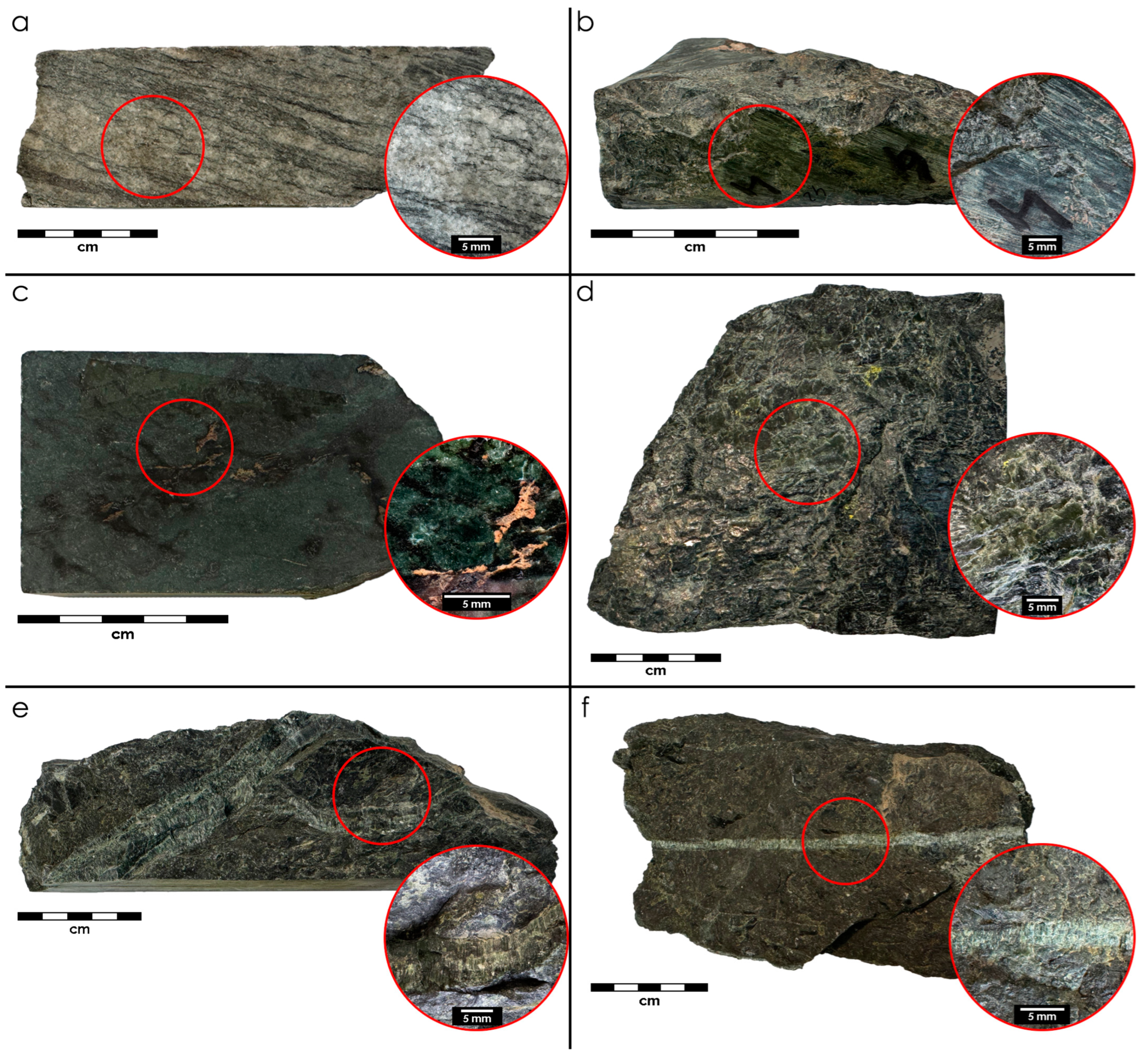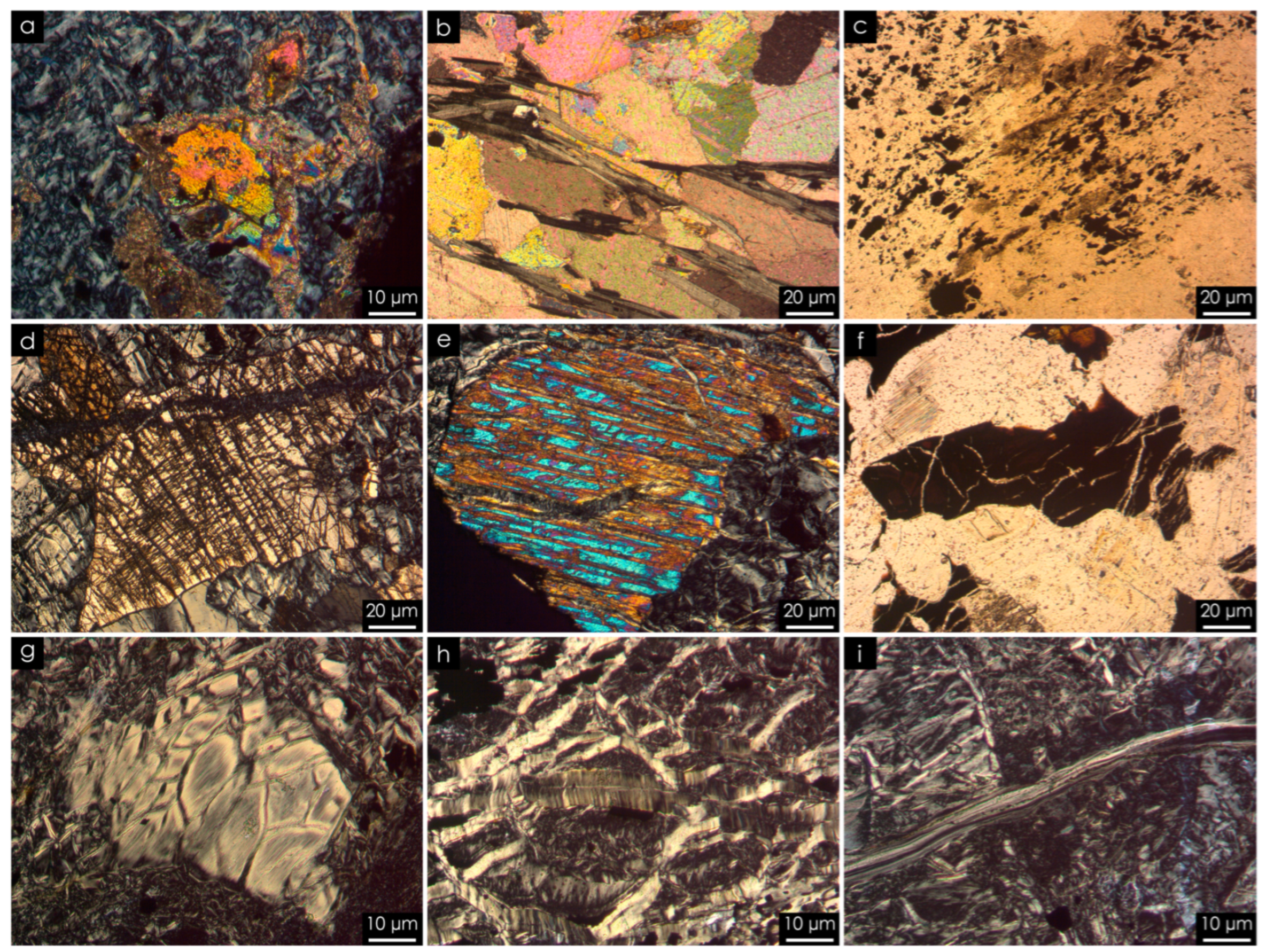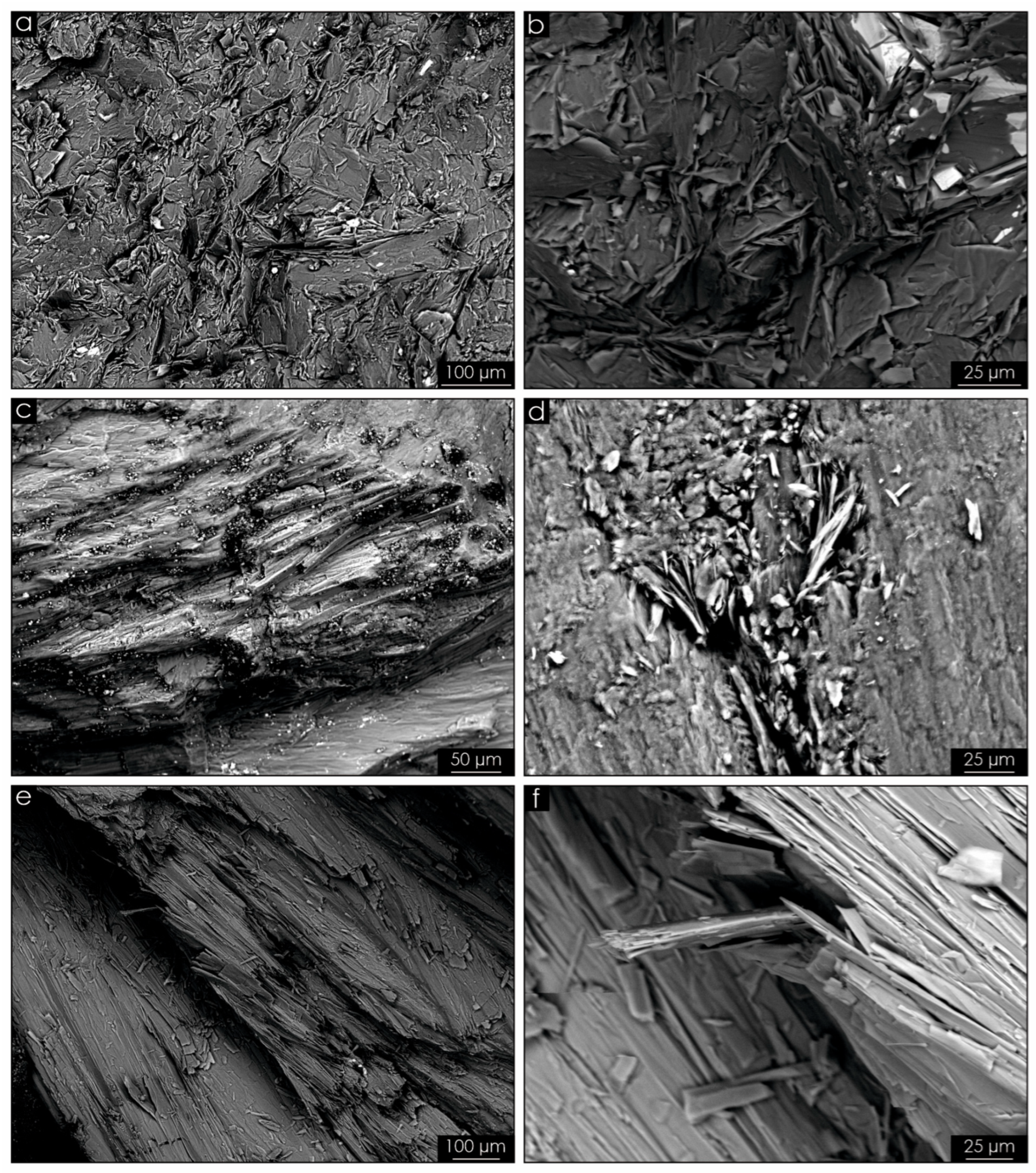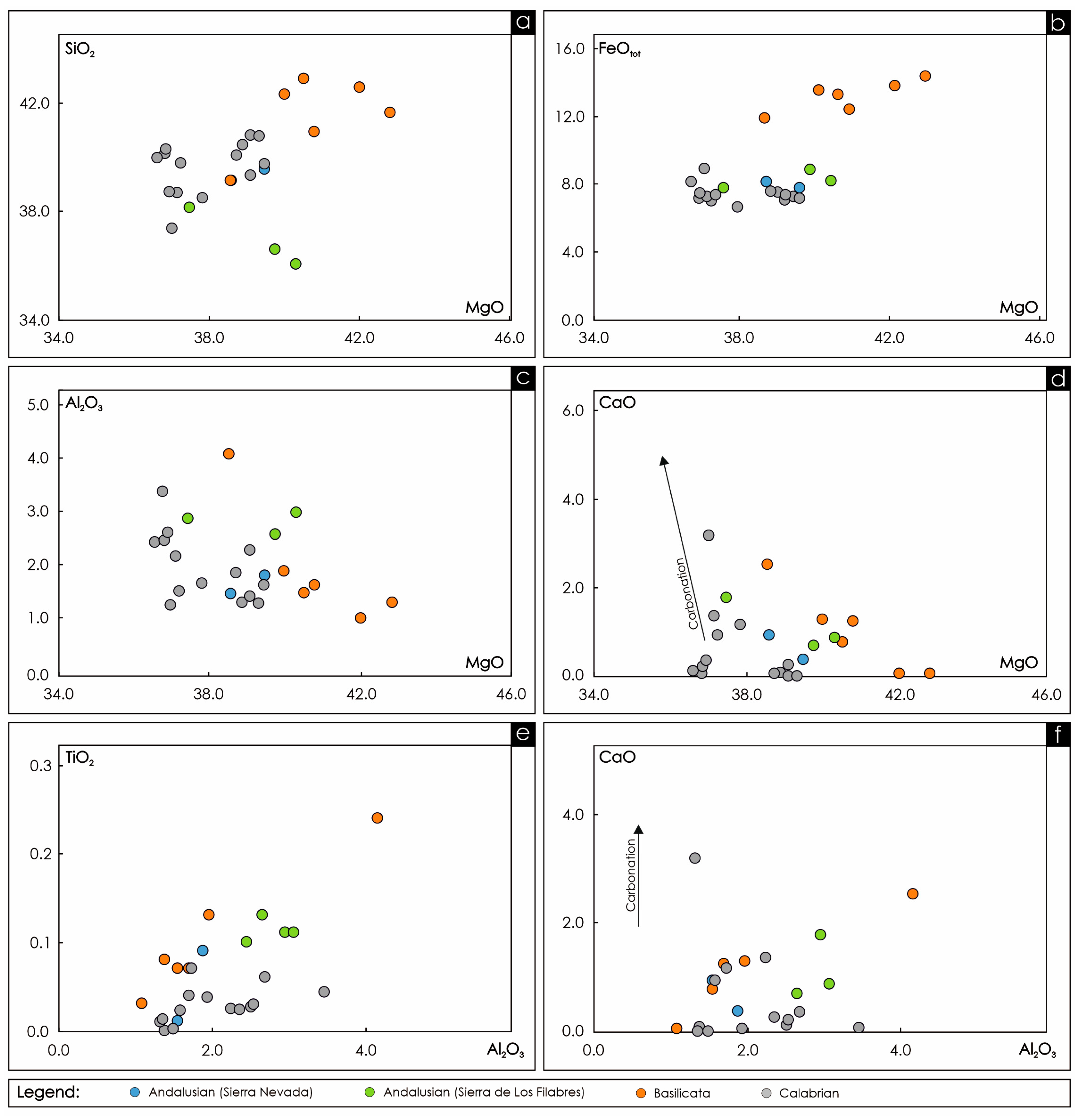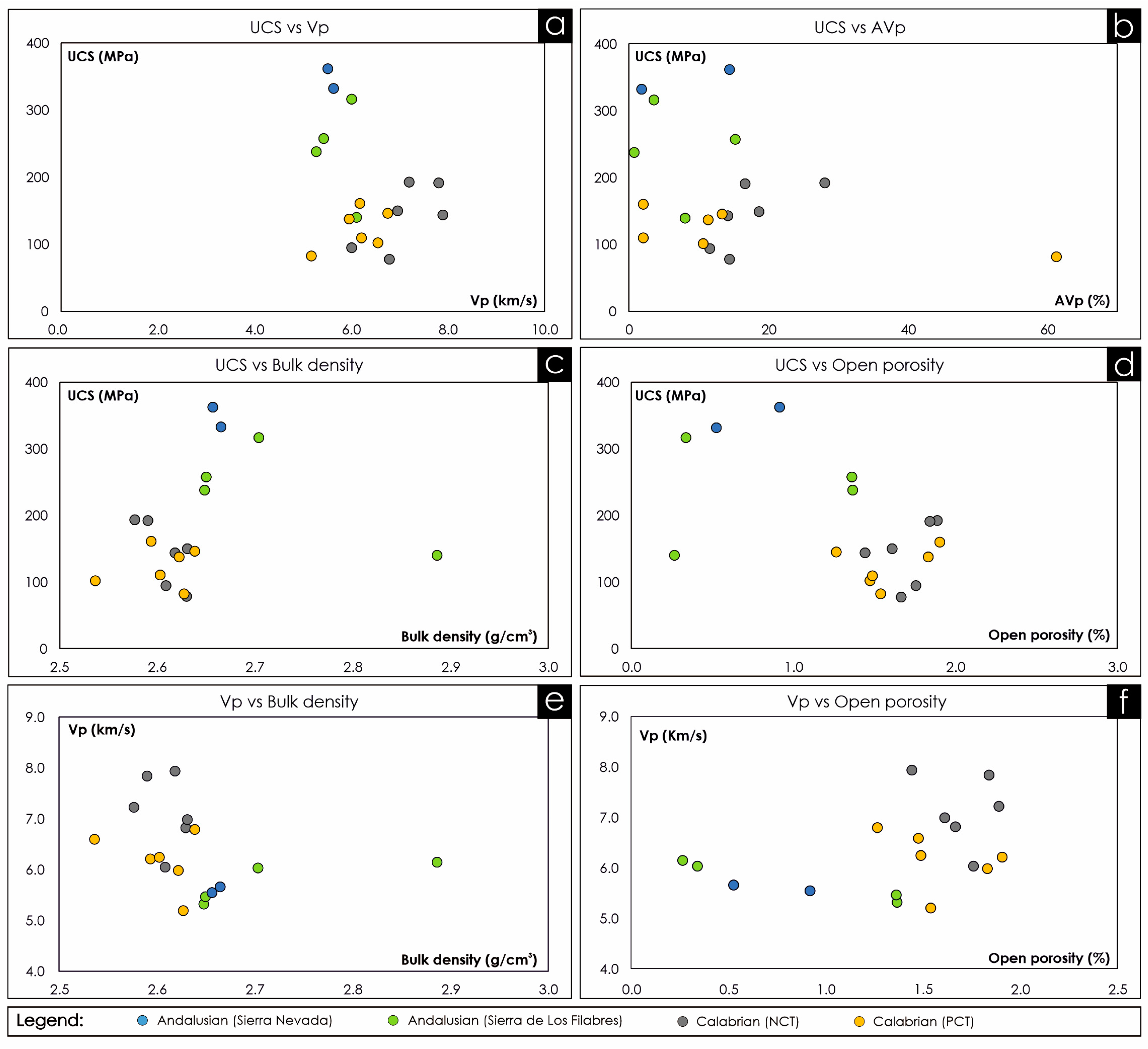1. Introduction
Serpentinites are metamorphic rocks constituted primarily by serpentine-group minerals (antigorite, chrysotile, lizardite) resulting from the transformation and low-temperature hydration of previous olivine-rich ultramafic rocks, such as dunite, lherzolite, wehrlite, and harzburgite [
1,
2,
3,
4,
5,
6,
7,
8,
9,
10,
11,
12,
13,
14,
15,
16,
17,
18,
19,
20,
21,
22,
23,
24,
25,
26,
27,
28,
29,
30,
31,
32,
33]. Along with the main constituents, serpentinites can contain other minerals such as chlorite, brucite, magnetite, talc, and amphiboles, as well as carbonates as secondary mineral phases, together with pyroxene, olivine, and spinel as evidence of the protolith relics.
Defining the protolith can sometimes be difficult due to the absence of primary minerals or to the mobility of petrogenetically discriminating elements [
3]. The geochemical signatures of key elements (e.g., Mg, Al, and Si) can provide useful clues to the recognition of the protoliths, as outlined by a decrease in the Al/Si ratio and an increase in the Mg/Si ratio at a high degree of partial melting in residual (i.e., depleted)-mantle peridotite [
3,
4,
5,
6,
7].
However, this approach alone cannot distinguish serpentinite origin from cumulates or residual-mantle peridotites. Still, it should be supported by the analysis of platinum-group elements that have proven to be useful in discriminating between the different origins mentioned above, as the partial melting fractionates them due to their different compatibilities [
3,
8,
9]. Whereas, the analysis of immobile elements in whole rocks and the composition of relict Cr-spinel provided a suitable approach in discriminating abyssal from forearc peridotites [
4,
10,
11,
12].
Serpentinites can be found in ancient orogenic belts associated with mafic igneous rocks (i.e., metabasite rocks) and chert. Such a suite of rocks is commonly known as ophiolites or the “Steinmann trinity” [
13,
14].
The peculiar features of the serpentinites, such as the greenish color and the intricate vein and mesh-like texture, as well as their role either in contributing to the geochemical cycle of subduction zones through fluid-mobile elements and water transfer [
15], or in CO
2 sequestration when carbonated [
16,
17], or as a source for the development of nickel ore deposits when weathered under humid tropical conditions [
18], have hugely increased interest in studying these rocks in recent decades.
Moreover, since antiquity, serpentinites have long been exploited, traded, and exported worldwide as daily tools as well as in buildings and decorative stones in both internal and external architectural elements because of their aesthetic appeal, attractiveness, and durability. These characteristics highlight their importance as building materials. Moreover, varieties of serpentinite, ophite in particular, are used as a jewelry and ornamental stone. Serpentinite was also actively used by ancient man for tools (e.g., axes) [
19]. However, relatively few studies approach this lithotype as dimension stones both from a perspective of conservation and restoration of pre-existing buildings as for the construction of new ones [
20,
21,
22,
23,
24].
In this work, we analyzed and compared petrographic features, geochemical signatures, and physical–mechanical properties of serpentinites from Andalusia (southern Spain), Basilicata, and Calabria (southern Italy) where they have been used as dimension stones in religious and civil buildings. We aim to evaluate and assess differences in petrographic, carbonation, uniaxial compressive strength, and seismic behavior that could affect their efficiency when these serpentinites are used as either construction materials or for conservation/restoration purposes in cultural heritage.
Application examples of the studied serpentinites may be found in various localities and buildings. For instance, Andalusian serpentinites can be found in the Alhambra, the Cathedral in Granada, and the Cathedral of Nuestra Señora de La Almudena, or the San Lorenzo de El Escorial Monastery in Madrid, among many places all over the country [
23,
25]. Calabrian serpentinites, used since prehistorical times for stone axes (Leighton), can nowadays be found either in local contexts such as in the S. Maria Assunta Church in Martirano Lombardo town, in the Chiesa Madre, and in the sanctuary of Santa Maria del Porto in Gimigliano town, as well as for the stairway within the church of Santa Maria del Gesù (Naples), or even for the internal decorations of buildings belonging to UNESCO World Heritage Sites (WHS) (e.g., church of San Nicolò L’Arena and the Cathedral in Catania, or the Certosa of Padula) (
Figure 1). Due to serpentinite outcrops in Basilicata, because of their tendency to break, they were exploited and used as inert materials and aggregates.
2. Brief Geological Background
A brief geological framework and a detailed description of the sampling location of the investigated serpentinites are summarized for the Andalusia, Basilicata, and Calabria regions, respectively.
2.1. Andalusian Serpentinites
The serpentinite quarries in the Andalusian region are in two main areas: Güejar-Sierra (Granada), and Macael (Almería) (
Figure 2). These areas are situated in southern Spain (
Figure 2a) within the Sierra Nevada National Park and Sierra de los Filabres (
Figure 2b), respectively. The serpentinites belong to the upper unit of the Nevado-Filábride Complex, which is the lowest metamorphic complex in the internal zones of the Betic Cordillera [
26,
27].
This upper unit comprises various rock types, arranged from bottom to top as meta-conglomerates, micaschists, light-colored quartzites, garnet-bearing schists, and marble layers. Additionally, the sequence includes bodies of metamorphosed igneous rocks, such as tourmaline-bearing orthogneisses, which are interspersed throughout.
The Andalusian serpentinites investigated originated from lens-shaped bodies of basic and ultrabasic rocks that are intercalated within this upper unit, with sizes ranging from meters to kilometers. These bodies were entirely or partially metamorphosed into eclogites, amphibolites, and serpentinites. The following different lithotypes can be recognized: (i) serpentinites containing diopside and Ti-clinohumite along with metamorphosed ultramafic rocks derived from transformed lherzolites and serpentinized secondary harzburgites; and (ii) meta-doleritic dykes occurring as decimetric-sized lenticular bodies, embedded within the serpentinites, metamorphosed into metarodingites or eclogites.
2.2. Basilicata Serpentinite
The serpentinite rocks in the Basilicata region crop out in the Pollino Massif (southern Apennines, Italy). In particular, the ancient quarries where these serpentinites were exploited are located near San Severino Lucano and Episcopia settlements (
Figure 2c,d).
The Pollino Massif (PM) is formed from a combination of Mesozoic and Tertiary magmatic and sedimentary rocks, which are associated with the Ligurian ocean basin and the African passive margin. These lithologies are overlain by Pliocene–Pleistocene terrestrial deposits [
31]. Together, the P M and the continental crustal rocks constitute the Liguride Complex of the Apennines and the Calabria region [
32,
33,
34,
35,
36,
37].
The Liguride Complex consists of tectonic units including bodies of oceanic and continental crust [
38] as well as sedimentary sequences (Upper Jurassic to Upper Oligocene age, [
35]). The tectonic units are covered by mid–late Oligocene to early–mid Miocene turbidite sequences. According to [
39], the Liguride Complex consists, from bottom to top, of the North Calabrian Unit, the Frido Unit, and the Crystalline metamorphic Units [
39].
The Frido Unit tectonically overlies the North Calabrian Unit and forms the structurally highest tectonic unit in the Liguride Complex [
40]. Several interpretations have been proposed for the origin of the Liguride Complex [
39,
41,
42] and its genesis has long been debated.
The Frido Unit includes a metasedimentary sequence [
43] and an incomplete ophiolite, consisting of serpentinite, metabasalts, metagabbro, meta pillow lavas, and dismembered meta dolerite dikes while the North Calabrian Unit is composed of the Crete Nere, the Saraceno and the Albidona formations [
39].
Finally, during their evolution, the Frido Unit rocks underwent HP-LT and blueschist facies metamorphism [
44], while those of the North Calabrian Unit have been affected by oceanic alteration and lack any orogenic metamorphism.
In addition, according to [
45,
46], the Pollino Massif is a fossil ocean–continent transition zone or a continental margin ophiolite.
Some authors (e.g., [
33]) suggest that metapelite rock assemblages, which include both continental crustal and ophiolite rocks, form a mélange zone known as the Episcopia–San Severino mélange. In contrast, other interpretations view the Liguride Complex as a stack of thrust sheets in an accretionary prism complex (e.g., [
35,
43]).
2.3. Calabrian Serpentinite
The investigated serpentinite rocks crop out in the northern sector of the Calabria region (
Figure 2e), where oceanic units are found between pre-Mesozoic continental crustal rocks (the Calabride Complex) at the top, and the Apennine carbonate units at the bottom [
47,
48].
In particular, the lowermost Apennine Complex consists of a thick Mesozoic carbonate succession that is partially metamorphosed, whereas the uppermost Calabride Complex includes a nearly continuous section of continental crust formed during the last stages of the Variscan orogeny, along with its original Mesozoic sedimentary cover (the Longobucco Unit). The investigated serpentinites belong to the intermediate Liguride Complex, which consists of oceanic units that are evidence of relics of the Tethys Ocean, primarily involved in subduction and later in continent–continent collision events that have an eastward tilt towards Europe.
The entire ophiolite sequence is observable in the Gimigliano–Mount Reventino area (
Figure 2f) and comprises mantle-derived, serpentinized ultramafic rocks and ophicalcites. Geochemical analysis of the basaltic protoliths indicates a typical mid-ocean ridge basalt (T-MORB) affinity and suggests that they originated from harzburgitic-lherzolitic rocks [
49,
50]. High-pressure/low-temperature (HP/LT) metamorphism, with pressures ranging from 0.9 to 1.1 GPa and temperatures around 350 °C, is indicated by the mineralogical assemblages found in metabasite and metapelite rocks [
47,
51,
52]. According to [
47,
53], at the summit of Mount Reventino massive and banded lenses of metabasalts and serpentinites do occur; they exhibit irregular structures and have been deformed into tight folds because of an antiform affecting the entire ophiolite sequence. Abandoned quarries in this area constitute evidence of past exploitation of serpentinite as dimension stone, as do other quarries found near the villages of San Mango and Gimigliano (
Figure 2f).
3. Materials and Methods
For the present study, we analyzed some representative samples of the studied serpentinites: six Andalusian serpentinite samples, two samples from the Basilicata quarries, and two samples from the Calabrian quarries.
The Andalusian serpentinites come from three different quarries: the Barranco de San Juan (
Figure 3a) in Sierra Nevada (Granada); the Virgen de Rosario (
Figure 3b), and C.E. Verde (
Figure 3c) in Sierra de los Filabres (Almería).
The Barranco de San Juan quarry was chosen due to its historical significance, as it has been exploited since the sixteenth century for the extraction of the “Verde Granada” variety (
Figure 4a), which was used as dimension stone in important heritage buildings throughout Spain [
23]. Here, we sampled two specimens differing in their green color; one lighter (M1) and one darker (M2).
The Virgen de Rosario quarry is located near the village of Macael, known for the White Macael marble [
25], where two samples representative of the Verde Macael variety (
Figure 4b) were selected on the basis of their higher (M3) or lower (M4) degree of carbonation. The C.E. Verde quarry is located ~15 km southeast of the Macael village, and two dark-green serpentinite samples (M5-M6) were selected as representative of the Verde Almeria variety (
Figure 4c).
The Basilicata serpentinites were collected at the Timpa Castello and Pietrapica quarries (
Figure 3d), located ~3km east of the Episcopia village at the Calabria–Lucanian boundary (
Figure 2d). The serpentinites collected in the Pietrapica quarry (S1–S2 samples) are dark green and appear intensely affected by brittle deformation showing cataclastic textures with slip surfaces resembling badland-like morphology [
17]. Moreover, serpentinites have several talc-rich bodies associated with carbonate veins and are characterized by brecciated textures.
The Calabrian serpentinite samples were collected on the basis of their historical importance and their mesoscopic characteristics in the abandoned quarries close to the town of Gimigliano (
Figure 3e) and at Mount Reventino (
Figure 3f). These sites represent evidence of the exploitation and trading of the Calabrian serpentinite as dimension stone used either for the external parts or the internal architectural elements in religious and civil buildings [
30]. At the mesoscale, the serpentinites appear dark green, massive (REV lithotypes) to weakly-foliated (GIM lithotypes), and fractured to various extents. In both cases, it is possible to observe widespread millimetric to centimetric (rare) vein systems crosscutting the massive bodies. These veins are constituted by greyish to bright green serpentine commonly arranged perpendicular to the length axis of the vein and associated with minor calcite [
30,
49]. Moreover, in the abandoned quarry near Gimigliano it is possible to recognize various blocks of ophicalcite, since calcite surrounds serpentinite blocks.
To carry out a complete petrographic characterization of the selected serpentinites, optical investigation on thin sections was conducted using a Zeiss Axio Lab.A1 microscope, whereas high-resolution thin section scans (
Figure 5) were acquired through an Epson V750 Pro dual-lens system scanner with a resolution of 4800 dpi and a pixel size of ~5 µm. Both instruments are available at the Department of Biological, Geological, and Environmental Sciences of the University of Catania.
These optical observations were further integrated with a morphological investigation of small pieces detached from the investigated serpentinites to highlight the occurrence of fibrous minerals. This morphological analysis was conducted through an energy-dispersive X-ray spectroscopy, EDAX Neptune XM460 series, assembled on a TESCAN VEGA LMU scanning electron microscope (SEM) at the University of Catania.
Whole-rock geochemical features available in the literature from previous works by the present authors [
17,
27,
49] have been integrated and compared for the investigated serpentinites. These comprise either major or minor elements, obtained by various analytical methodologies (for details please refer to [
17,
27,
49]).
Data on petrophysical properties of the serpentinite rocks from the quarries in Calabria and Spain have been retrieved from previous works by authors [
27,
54], whereas no previous literature was found on petrophysical properties of serpentinite from Basilicata; neither it was possible to shape a sufficient number of specimens for petrophysical investigation because of widespread fracturing affecting the serpentinite rocks from the historical quarries in Basilicata. For these latter, some specimens were obtained from the blocks fractured to a lesser extent. Nevertheless, only measurements of compressional wave velocities were carried out for these serpentinites due to the difficulty of obtaining cubes during the sample preparation. The non-destructive ultrasonic wave velocity test was carried out at standard conditions according to the ASTM designation (D2845-00). The device used for measurements of transit time (ms) is the A5000M pulse transmitter (MAE s.r.l.), with transducers operating at 50 kHz and an accuracy of ±0.3 ms. The petrophysical data referring to the ultrasonic wave velocity tests were carried out in the two groups (i.e., Andalusian and Calabrian) at laboratory pressure and temperature conditions. The anisotropy was calculated according to [
55]: A% = 100(Vmax − Vmin)/Vmean.
Additionally, salt crystallization tests were performed on serpentinites from Calabria to evaluate their durability and the potential formation of microfractures due to external agents. The methodology followed is detailed in [
54]. To compare the mechanical behavior of the stone before and after crystallization (non-crystallization test–NCT and post-crystallization test–PCT), parameters such as Vp, bulk density, open porosity, and uniaxial compressive strength were measured before and after the test.
4. Results
4.1. Petrographic and Microstructural Features
At the microscale, Andalusian serpentinites (
Figure 5a,b) show a main mineralogical assemblage given by serpentine plus olivine, pyroxenes, chlorite, amphiboles, carbonates, talc, and opaque minerals (e.g., magnetite, pyrite, ilmenite, chromite).
Serpentine is the most abundant phase, even though among the studied samples, the Verde Macael variety (M3, M4 samples) show major amounts of carbonates (i.e., calcite and dolomite), testifying to an advanced carbonation process (
Figure 5b). Olivine, pyroxene, and amphibole are recognized in the Barranco de San Juan (M1, M2) and Virgen the Rosario (M3, M4) samples (
Figure 6a). Chlorite, chromite, magnetite, and to a lesser extent, pyrite, ilmenite, and hematite are also identified in the Verde Almeria variety (M5, M6). Talc occurs as a secondary mineral in the Verde Granada and Verde Almeria varieties. The rock fabric is characterized by non-pseudomorphic interpenetrating textures [
56] defined by serpentine intertwined flakes, crystal plates, and elongated blades, although in some areas can be observed in pseudomorphs of the relict minerals as well as in the shape of the porphyroclast of the original mineral of the protolith. Only sample M3 from the Virgen de Rosario quarry shows a granoblastic texture where carbonate grains are elongated and interlayered with serpentine fibers oriented in the same direction (
Figure 6b). Also, sample M1 from the Barranco de San Juan quarry shows preferred orientations as outlined by magnetite grains (
Figure 6c). Many fractures filled by serpentine and carbonates are also frequent in all investigated serpentinites. The SEM morphological analysis revealed interpenetrating crystal plates of serpentine group minerals with fibrous serpentine flakes generating within the matrix, along with the presence of iron oxides (
Figure 7a,b).
Basilicata serpentinites (
Figure 5c,d) consist of olivine, clinopyroxene, orthopyroxene, and spinel as primary minerals together with secondary minerals represented by serpentine, chlorite, magnetite, prehnite, and amphibole. Epidote and Fe-hydroxides also occur as accessory minerals. The rock fabric can be discerned by two different textures: (i) a pseudomorphic texture (
Figure 5c) given by mesh textures where relict olivine crystals are replaced by an association of serpentine + magnetite, and relics of orthopyroxene [
56,
57,
58]; and (ii) a vein texture characterized by millimetric veins crosscutting the pseudomorphic textures and cutting each other. As regards the protolith minerals, while olivine can be found locally within the mesh textures at the core of the serpentine + magnetite pseudomorphs (
Figure 6d), orthopyroxene can be recognized both as fresh porphyroclasts and as pseudomorphs with the original prismatic habit. Also, it can be found as exsolution lamellae in clinopyroxene porphyroclasts (
Figure 6e). Clinopyroxene is also frequent and commonly rimmed by amphibole recognized in the actinolite-tremolite series on the base of optical features, whereas spinel occurs as hollyleaf-shaped xenomorph porphyroclasts and variably fractured (
Figure 6f), typical of porphyroclastic upper mantle peridotites [
59]. In some cases, spinel crystals are bordered by fine-grained chlorite or replaced by pseudomorphic fine-grained magnetite aggregates. Numerous vein networks filled with serpentinite and, to a lesser extent, chlorite, prehnite, and amphibole, crosscut the investigated serpentinites. Finally, talc is found associated with carbonate and serpentine veins. The SEM morphological analysis highlighted the typical lamellar habits of serpentine minerals with initial fibril development (
Figure 7c) and zones where separable serpentine fibers occur (
Figure 7d).
Calabrian serpentinites (
Figure 5e,f) have a main mineralogical assemblage made of serpentine-group minerals (i.e., chrysotile, lizardite, and antigorite), magnetite ± amphibole (tremolite-actinolite) ± chlorite ± clinopyroxene ± Cr-spinel. Calcite is abundant, especially in the ophicalcite samples. Olivine and orthopyroxene are in most cases completely replaced by pseudomorphs of serpentine + magnetite aggregates with typical mesh microstructures (
Figure 6g) that also constitute the fine-grained rock matrix. Clinopyroxene is found as millimeter-sized grains or as inclusions within the Cr-spinels of the original ultramafic rock. The latter show hollyleaf habits like Cr-spinels from Basilicata samples and are commonly almost completely retrogressed to magnetite and chlorite. Serpentinites are crosscut by different vein networks filled with serpentine fibers oriented either perpendicular to the vein or according to its axial length (
Figure 6h,i). In most cases, tiny magnetite grains mark the central line of the vein. Moreover, part of the veins can be filled by minor calcite and talc flake aggregates or amphibole (actinolite-tremolite) fibers. The latter may also occur within the serpentine matrix. The rock fabric is characterized by a typical mesh microstructure, sometimes showing remnants of the primary protogranular microstructure inherited from the ultramafic protolith. The SEM morphological analysis indicated the flaking of the massive portion showing the separation of chrysotile fibers along their elongation direction (
Figure 7e,f). Moreover, SEM-EDS analysis indicated that the representative composition of fibrous chrysotile is (Mg
2.48Fe
0.12Ca
0.02Cr
0.03Al
0.27)(Si
2.87Al
0.13)O
5(OH)
4.
4.2. Whole-Rock Geochemistry
To characterize the geochemical signatures of the investigated serpentinites from the three different regions, representative bulk-rock data (
Table S1) from [
17,
27,
49] were compared through binary diagrams using Al
2O
3 and MgO as the main variation indexes (
Figure 8). These oxides are better indicated to distinguish primary peridotite rather than secondary serpentinization [
49].
The analysis of the whole-rock chemistry (
Figure 8) reveals similar SiO
2 contents for the Andalusian (36%–40%) and Calabrian (37%–41%) serpentinites, whereas Basilicata serpentinites show slightly higher values (39%–43%).
The same trends are observed for FeOtot, which shows contents in the range 8%–9% for Andalusian serpentinites, 7%–9% for Calabrian serpentinites, whereas higher values are observed for the Basilicata samples (12%–14%). Al2O3 shows lower values in the Andalusia serpentinites from Sierra Nevada (BSJ: 1.6%–1.9%) compared to the Sierra de los Filabres samples (VR and CEV: 2.5%–3.1%). Overall, Al2O3 contents appear relatively constant, in the range (1%–4%), across all the investigated rocks, with the lowest and highest values observed in the Basilicata serpentinites (i.e., 1.1% and 4.2%). CaO contents are mainly in the range of 0%–1%, except for one sample from Andalusia 37.3%), one from Basilicata (2.5%), and one from Calabria (3.2%), testifying to a higher degree of carbonation.
MgO varies mainly in the range 37%–40% in the Andalusian rocks, except for the most carbonated specimen (12.3%). In the Basilicata samples, it varies between 39% and 43%, whereas in the Calabrian serpentinites, MgO ranges between 37% and 39%, with the higher values mainly observed in samples from the Mount Reventino quarry (
Table S1). TiO
2 concentrations (<0.3%) show an increasing trend from Calabria to Basilicata serpentinites, whereas Andalusian serpentinites show lower contents in the Sierra Nevada samples (BSJ) compared to the Sierra de los Filabres (VR and CEV) ones (
Figure 8). Magnesium numbers (Mg# = MgO/(MgO + FeO
tot) show comparable ratios in serpentinites from Andalusia (0.82–0.84) and Calabria (0.81–0.85), whereas lower values are observed in Basilicata serpentinites (0.75–0.77). MgO/SiO
2, and Al
2O
3/MgO show similar average values in all samples, with higher values in the Al
2O
3/MgO for the Sierra de los Filabres (VR and CEV) compared to the Sierra Nevada (BSJ) samples in the case of the Andalusia serpentinites. CaO/Al
2O
3 ratios higher than 1% characterize carbonated serpentinites, whereas lower values are typical of preserved ones.
4.3. Petrophysical Features
Table 1 shows the main petrophysical features of the analyzed serpentinites.
The P-wave velocities show significant differences between the regions analyzed. In serpentinites from Sierra Nevada (BSJ), the values are relatively homogeneous, with an average of Vp
x = 5.70 km/s, Vp
y = 5.36 km/s, and Vp
z = 5.70 km/s. The maximum and minimum values show limited variation, with a maximum of 5.82 km/s in Vp
x (M2) and a minimum of 5.02 km/s in Vp
y (M2), suggesting a more isotropic and uniform structure. With respect the serpentinites from Sierra de los Filabres (VR and CEV), the velocities are slightly higher and exhibit greater dispersion, with averages of Vp
x = 5.86 km/s, Vp
y = 5.52 km/s, and Vp
z = 5.81 km/s. The extreme values range from a maximum of 6.30 km/s in Vp
x and Vp
z (M-3) to a minimum of 4.90 km/s in Vp
y (M6). The specimen with the highest average value of Vp is the M-3 sample, with high carbonate content (
Table 1) consisting mainly of dolomite (Vp = 7.37 km/s) and calcite (Vp = 6.54 km/s), as also pointed out by its geochemical features. Calabria shows the highest values and the greatest anisotropy, with averages of Vp
x = 6.74 km/s, Vp
y = 7.34 km/s, and Vp
z = 7.30 km/s. The dispersion is more pronounced, with values ranging from a minimum of 6.19 km/s in Vp
x (GML8-1) to a maximum of 8.32 km/s in Vp
z (GML8-8) and average values ranging between 6.03 and 7.92 km/s, reflecting significant structural variability and possibly a preferential orientation of minerals.
In terms of anisotropy, serpentinites from Sierra Nevada (BSJ) and Sierra de los Filabres (VR and CEV) exhibit relatively low values, with averages of 8.21% and 7.04%, respectively. However, within the Sierra de los Filabres group, there are samples with virtually zero anisotropy, such as sample M5, with a value of 0.91%. The anisotropy range in the Sierra Nevada samples varies between 1.90% and 14.52%, while in Sierra de los Filabres, it ranges from 0.91% to 15.42%. Calabria shows the highest anisotropy, with an average of 17.39% and values ranging from 11.71% to 28.20%, suggesting significant variability in seismic velocities based on the propagation direction.
The density varies between regions. Sierra de los Filabres specimens show the highest values, with an average of 2.72 g/cm3 and a range from 2.65 g/cm3 (M-5, M-6) to 2.89 g/cm3 (M-3), which may be related to a higher proportion of carbonate contents (dolomite 2.85 g/cm3) or denser minerals such as oxides or sulfurs (e.g., magnetite–5.15 g/cm3 or pyrite–5010 g/cm3) as was pointed out in the mineralogy analysis. Serpentinites from Sierra Nevada and Calabria have more similar values, with averages of 2.66 g/cm3 and 2.61 g/cm3, respectively, with all the samples being very homogeneous.
In general, the open porosity is low, and is lower in the Andalusian serpentinites, with values ranging between 0.27% and 1.37% (average 0.80%), while in the Calabrian serpentinites, porosity varies between 1.45% and 1.90%, with 1.71% as the average value.
The uniaxial compressive strength (UCS) shows notable differences between regions. In Andalusia, those from Sierra Nevada (BSJ) exhibit the highest strength, with an average of 345 MPa and values ranging from 331 (M-1) to 361 MPa (M3), with reduced variability. In Sierra de los Filabres (VR and CEV), the average value is 237 MPa, but shows high dispersion standard, with a maximum of 315 MPa (M-4) and a minimum of 139 MPa (M-3), indicating differences in the quality and compaction of the samples, showing the differences mainly related to the carbonate content. The average value for the Andalusia samples is 273 (±81) MPa. Calabria shows the lowest strength, with an average of 141 MPa and values ranging from 77 (GML7-4) to 190 MPa (CNF16-3). Additionally, the dispersion in this region is the highest, with a standard deviation of 48 MPa, which aligns with the high anisotropy and structural heterogeneity observed in its samples.
As for the serpentinite rocks from Calabria [
54], the investigation highlighted that their petrophysical behavior may be affected by environmental conditions when they are used for external stone material.
Table 2 shows the results of measuring different petrophysical properties before (NCT) and after (PCT) the salt crystallization test.
Salt crystallization tests on the serpentinite cubes showed that after 35 cycles, salts tend to form crystals both within microfractures and along veins, which increases pressure and results in the breakage of some specimens at 13–15 cycle. In some cases, the replacement of calcite by soluble salts within microfractures was observed along with some decay forms such as exfoliation of the specimen surfaces. The average compressional velocity values are in the range between 6.00 and 7.50 km/s in samples where no crystallization tests were performed. In contrast, after crystallization tests the average values decrease in the range 5.19–6.78 km/s (
Table 2) due to the fracture development within the rock. Regarding the Vp-related seismic anisotropy after the crystallization test, values (AVp) increase from 14% to 17% (average values). However, it is important to highlight the high standard deviation, which reflects the heterogeneity of this type of sample. Tested specimens generally exhibit a low porosity grade of less than 5%, with average porosity varying from 1.71% for NCT samples (
Table 1) to 1.59% for PCT samples (
Table 2) and UCS that varies between 141 MPa for NCT samples (
Table 1) and 122 MPa for PCT samples (
Table 2).
5. Discussion
Serpentinite rocks sampled from historical quarries in the three selected regions (i.e., Andalusia, Basilicata, and Calabria) are characterized here using a multi-analytical approach exploring their petrographical, mineralogical, geochemical, and petrophysical features. These unique features not only give them a fashioned appearance but also influence their performance in various applications. Like all rocks used in construction, serpentinites undergo several transformations when they are extracted from natural ophiolite outcrops and processed into building materials. Understanding of these properties is essential to prevent unexpected behavior when serpentinite is used as building stone or as a construction material. Additionally, this knowledge provides a reliable method for determining the provenance of serpentinite utilized in monuments.
From a petrographic and microstructural point of view, the serpentinites from Andalusia, Basilicata, and Calabria are characterized by distinct mineral assemblages and textures. While serpentine is the dominant phase across these regions, the abundance of other minerals such as olivine, pyroxenes, and magnetite is different. Additionally, some specimens (e.g., M3–M4 samples from Andalusia) display more advanced stages of carbonation. The textures observed in the investigated samples span from interpenetrating non-pseudomorphic fabrics to well-defined pseudomorphic and vein textures, all of which affect the overall rock structure and its mechanical behavior.
Whole-rock geochemistry indicates that while the SiO
2 contents are relatively similar for Andalusian and Calabrian samples, Basilicata specimens exhibit higher contents. Moreover, significant differences in the concentration of FeO, CaO, MgO, and other oxides are observed across the investigated regions. As for the mineralogy and textural features, these geochemical variations play a crucial role in influencing the petrophysical properties and mechanical strengths of the serpentinites, as noted by several authors [
24,
27,
60,
61,
62].
In the case of the analyzed samples, those from Andalusia—except for sample M3—exhibited very high uniaxial compressive strength (UCS) values, ranging from 237 MPa to 361 MPa, which are notably higher than those from Calabria (77–191 MPa). Although both groups of samples are mineralogically similar, as shown in
Figure 8, they exhibit slight geochemical differences that are likely related to the geological context.
In the Andalusian samples, the presence of minerals rich in FeO, such as magnetite, may contribute to increased strength, in contrast to samples with a higher serpentine mineral content, which tend to be mechanically weaker [
60]. According to these authors, a finer grain size in serpentine minerals can promote intergranular microfractures under compressive stress, thereby reducing rock strength. In the case of the Andalusian sample M3, intense carbonation has led to the development of microfractures within the rock, significantly reducing its strength compared to other samples from the same quarry that are less carbonated (e.g., M4), as previously reported by [
27].
When comparing the two groups of serpentinites in terms of sonic velocity (Vp), UCS, bulk density, and porosity, significant differences in their mechanical behavior are observed. In general, UCS tends to increase with higher density and unit weight, decrease with increasing porosity, increase with higher sound velocities, and decrease with higher degrees of serpentinization. Additionally, several external factors, such as the size and shape of the tested sample (cylindrical, cubic, or prismatic), the rate of load application, and the direction of load application in anisotropic samples, also play a crucial role in determining mechanical strength [
63,
64]. For this reason, direct comparisons between samples from different origins are not recommended.
As shown in
Figure 9a–f, when the data are analyzed as a whole, no clear relationships between the different parameters are observed, with a high degree of data dispersion. However, a certain linear relationship between density and UCS, as well as an inverse correlation between porosity and UCS, is evident, which aligns with expected trends.
The serpentinites from Andalusia are characterized by higher densities (2.65–2.89 g/cm
3), lower open porosity (0.27%–1.37%), and significantly higher uniaxial compressive strength (UCS) (237–361 MPa), despite exhibiting lower Vp values (5.30–6.13 km/s) compared to the serpentinites from Calabria. Additionally, the degree of anisotropy is slightly lower in the Andalusian samples (
Figure 9a–f). This behavior suggests that the Andalusian serpentinites have a more compact and cohesive internal structure, with lower porosity and a mineralogical arrangement that enhances mechanical strength, except for sample M3.
Conversely, the serpentinites from Calabria exhibit significantly higher Vp values (6.03–7.92 km/s) but generally lower UCS values (77–191 MPa), slightly lower densities (2.58–2.63 g/cm
3), and higher porosity (1.45%–1.90%). This suggests that although seismic waves propagate more rapidly through these rocks, their internal structure may contain a higher number of fractures and pores, reducing their mechanical strength. In particular, sample GML7-4 has a relatively high Vp (6.81 km/s) but the lowest UCS of the group (77 MPa), reinforcing the hypothesis that sonic velocity is not an absolute predictor of strength in these rocks, as previously noted by other authors [
24,
57].
Regarding the results after the salt crystallization test, a notable reduction in the average Vp, an increase in anisotropy, and a decrease in mechanical strength were observed, as expected. The crystallization of salts within the rock generates pressures that induce the formation of microfractures [
65], thereby reducing mechanical strength and increasing anisotropy, as previously reported by other authors [
66,
67,
68].
However, contrary to expectations—given the decrease in UCS and Vp [
69,
70]—porosity was slightly reduced compared to the initial state. This could be due to the crystallization of salts within the pores or microfractures, which reduces the amount of accessible porosity for water.
6. Final Remarks
In conclusion, this study reports and compares the main features of serpentinites from historical quarries, whose materials have been used since ancient times, providing in turn a state of the art analysis of available data on serpentinite exploited in various localities and used for different purposes. Serpentinites from Andalusia, Basilicata, and Calabria all primarily consist of serpentine but differ significantly in relict minerals such as olivine and pyroxene as well as in accessory minerals. These differences lead to distinct textures spanning from non-pseudomorphic interpenetrations to well-defined pseudomorphic and veined fabrics which affect the rock microstructural integrity and mechanical response. From a geochemical perspective, Andalusian and Calabrian serpentinites have similar silica content, whereas Basilicata samples exhibit higher values. Also, it is recognized that variability in iron, calcium, and magnesium oxides affects bulk density, porosity, P-wave velocities as well as uniaxial compressive strength (UCS), suggesting that even small variations in these oxide contents can lead to measurable differences in rock performance. Andalusian samples (except for the most carbonated sample, M3) are characterized by higher UCS values when compared with Calabrian samples due to the presence of magnetite, which contributes to increased strength. In contrast, the occurrence of abundant fine-grained serpentine or intense carbonation can lead to the formation of microfractures that weaken the rock. In all investigated samples, higher bulk density and ultrasonic velocity are generally associated with high UCS, whereas higher porosity correlates with lower strength. Salt crystallization tests performed on Calabrian samples highlight an increase in anisotropy and a decrease in ultrasonic velocity as well as in UCS due to the formation of microfractures.
Results obtained from petrophysical investigations of serpentinites from the historical quarries located in the Andalusia and Calabria regions highlight that their properties meet the standards established by the American Society for Testing and Materials (ASTM), which require a UCS higher than 69 MPa and a ρ greater than 2.56 g/cm3. As a result, these materials, depending on their petrophysical features, are suitable for use in construction to a various extent and are considered a valuable georesource, following a detailed characterization carried out before their implementation in construction or conservation/restoration of architectural heritage. On the contrary, samples from Basilicata region are characterized by widespread fracturing that make them unsuitable for use as building stone.
Finally, detailed microimaging indicated the presence of some minerals which may develop fibrous habit (i.e., chrysotile); therefore, when dealing with serpentinite as building rock, attention should be also paid to potential issues related to environmental and health implications.
